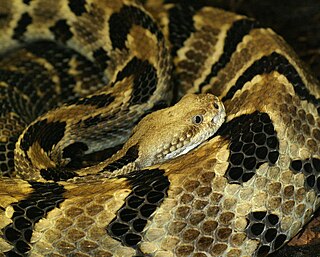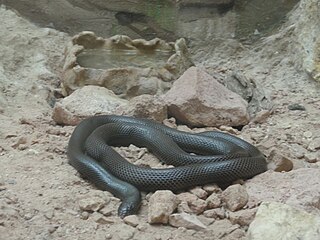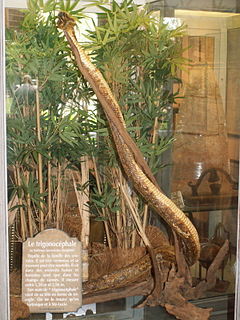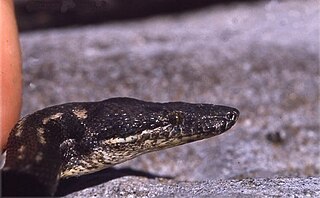
The Crotalinae, commonly known as pit vipers, crotaline snakes, or pit adders, are a subfamily of venomous vipers found in Eurasia and the Americas. They are distinguished by the presence of a heat-sensing pit organ located between the eye and the nostril on both sides of the head. Currently, 18 genera and 151 species are recognized: seven genera and 54 species in the Old World, against a greater diversity of 11 genera and 97 species in the New World. These are also the only viperids found in the Americas. The groups of snakes represented here include rattlesnakes, lanceheads, and Asian pit vipers. The type genus for this subfamily is Crotalus, of which the type species is the timber rattlesnake, C. horridus.

The Acrochordidae, commonly known as wart snakes, Java wart snakes, file snakes, elephant trunk snakes, or dogface snakes, are a monogeneric family created for the genus Acrochordus. This is a group of primitive aquatic snakes found in Australia and tropical Asia. Currently, 3 species are recognized.

The Typhlopidae are a family of blind snakes. They are found mostly in the tropical regions of Africa, Asia, the Americas, and all mainland Australia and various islands. The rostral scale overhangs the mouth to form a shovel-like burrowing structure. They live underground in burrows, and since they have no use for vision, their eyes are mostly vestigial. They have light-detecting black eye spots, and teeth occur in the upper jaw. The tail ends with a horn-like scale. Most of these species are oviparous. Currently, 18 genera are recognized containing over 200 species.

The Atractaspidinae are a family of snakes found in Africa and the Middle East, commonly called mole vipers, stiletto snakes, or burrowing asps. Currently, 12 genera are recognized.

Bothrops lanceolatus — known as the fer-de-lance, Martinican pit viper, and Martinique lancehead — is a species of pit viper generally considered endemic to the island of Martinique. No one has satisfactorily explained why it has flourished there but is unknown on nearly all other Caribbean islands. Some reserve the common name fer-de-lance for this species, while others apply that name to other Bothrops species as well. No subspecies are currently recognized.

The Leptotyphlopidae are a family of snakes found in North America, South America, Africa, & Asia. All are fossorial and adapted to burrowing, feeding on ants and termites. Two subfamilies are recognized.

The Aniliidae are a monotypic family created for the monotypic genus Anilius that contains the single species A. scytale. Common names include American pipe snake and false coral snake. It is found in South America. This snake possesses a vestigial pelvic girdle that is visible as a pair of cloacal spurs. It is ovoviviparous. It is non-venomous, and its diet consists mainly of amphibians and other reptiles. Currently, two subspecies are recognized, including the typical form described here.

The Bolyeriidae are a family of snakes native to Mauritius and a few islands around it, especially Round Island. They also used to be found on the island of Mauritius, but were extirpated there due to human influence and foraging pigs in particular. These snakes used to be placed in the Boidae, but are now classed as a separate family. Two monotypic genera are recognized, but only a single species is extant. Bolyeriidae appear to be most closely related to the Asian genus Xenophidion.

Xenopeltis is the genus of sunbeam snakes, of the monotypic family Xenopeltidae, the species of which are found in Southeast Asia. Sunbeam snakes are known for their highly iridescent scales. Currently, two species are recognized. Studies of DNA suggest that the xenopeltids are most closely related to the Mexican burrowing python, Loxocemus bicolor, and to the true pythons of Pythonidae.

Leptotyphlops is a genus of nonvenomous blind snakes, commonly known as slender blind snakes and threadsnakes, found throughout Africa. 11 species have been moved to the genus Trilepida, others moved to the genera Epacrophis, Namibiana, Myriopholis, Epictia, Siagonodon, Tricheilostoma, Tetracheilostoma, Mitophis, and Rena.

The Boinae are a subfamily of boas found in Central and South America as well as the West Indies. Six genera are currently recognized.
Typhlops is a genus of blind snakes in the family Typhlopidae. The genus is endemic to the West Indies. Some species which were formerly placed in the genus Typhlops have been moved to the genera Afrotyphlops, Amerotyphlops, Anilios, Antillotyphlops, Argyrophis, Cubatyphlops, Indotyphlops, Letheobia, Madatyphlops, Malayotyphlops, and Xerotyphlops.
Anomalepis is a genus of nonvenomous blind snakes found in Central and South America. Currently, 4 monotypic species are recognized.

Chilabothrus is a genus of non-venomous boas found in the West Indies. 13 species are currently recognized.
Anomalepis aspinosus is a species of snake in the Anomalepididae family. It is endemic to Peru. The skull and some of its permanently cartilagenous elements, as, for instance, the concha and other parts of the nasal capsule and the trabecule cranii have been studied. The trigeminal musculature and the depressor mandibulae has been observed. The head musculature proved to be different in many several points from Liotyphlops, the other partly investigated Anomalepine. Details on the exits of cranial nerves and the topography of the cranial glands has been studied in order to get a better understanding about the position and origin of the Typhlopoid snakes, which form a quite separate and not too small systematic unit strongly different from other groups of snakes. In order to get an idea of a primitive Typhopoid snake, information about the "aberrant" genera had to be combined with the already known features of the best-known genus, Typhlops; therefore, both Anomalepines had to be studied and compared with Typhlops. It is clear and evident that the Anomalepines are in many cranial characters more primitive than Typhlops, as by the presence of the remnant of the ancestral jugal arch(composed of the postorbital exclusively); by the presence of a big ectopterygoid and a prefrontal not fused with a rigid burrowing snout as in Typhlops. On the other hand, the fusion of the pair of nasals and the formation of a septum nasi osseum as a result of this fusion are features unknown in Typhlops. In Anomalepis, no tabular is found as in Liotyphlops. Typhlops, however, is more primitive in retaining a splenial in a peculiar position sharing with the dentary the symphysis. The peculiar retractor maxillae muscle of Typhlops is replaced by a double-bellied enlarged m. pterygoideus.
Anomalepis colombia is a species of snake in the Anomalepididae family. It is endemic to Colombia.
Anomalepis mexicanus is a species of snake in the Anomalepididae family.

The big-scaled blind snake is a species of snake in the family Leptotyphlopidae. It has reported from Panama, Colombia, Ecuador, Venezuela, the Guyanas and Brazil.














